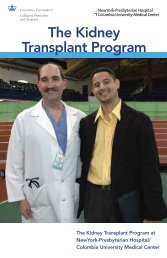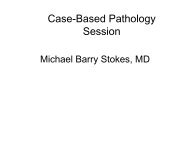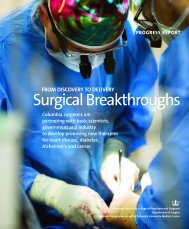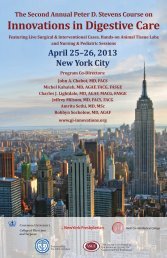NEWSLETTER - Columbia University Department of Surgery
NEWSLETTER - Columbia University Department of Surgery
NEWSLETTER - Columbia University Department of Surgery
You also want an ePaper? Increase the reach of your titles
YUMPU automatically turns print PDFs into web optimized ePapers that Google loves.
Jeffrey A. Ascherman<br />
Jeffrey Ascherman (P&S 1988) is the site chief <strong>of</strong> the division <strong>of</strong><br />
plastic surgery and director <strong>of</strong> the Cleft/Crani<strong>of</strong>acial Center at <strong>Columbia</strong>.<br />
Ascherman did his surgery and plastic surgery residencies<br />
at <strong>Columbia</strong> to be followed by two fellowships in Paris, in crani<strong>of</strong>acial<br />
surgery with Daniel Marchac at the Hospital Necker-Enfants<br />
Malades, in pediatric plastic surgery with Bernard Pavy at the Hospital<br />
<strong>of</strong> Saint Vincent de Paul. He has been back at <strong>Columbia</strong> since<br />
Lloyd A. H<strong>of</strong>fman, Jeffrey A. Ascherman, Robert T. Grant<br />
1995, has published over 50 papers and book chapters on adult and<br />
pediatric reconstructive surgery. His main areas <strong>of</strong> interest have<br />
been in Pediatric/Crani<strong>of</strong>acial surgery and TRAM (transverse rectus<br />
abdominus muscle) flaps for breast reconstruction. His paper on<br />
using pectoralis major advancement flaps to manage complicated<br />
sternal wounds in immunosuppressed heart transplant patients is<br />
widely quoted. 19 His 2008 report on abdominal wall morbidity after<br />
117 TRAM breast reconstructions with mesh support for the donor<br />
site had an overall complication rate <strong>of</strong> 6% including only one hernia<br />
and two superficial infections that did not require removing the<br />
mesh, and no TRAM flap losses. 20<br />
Jeff Ascherman still finds time to do bench work, usually in the<br />
cardiothoracic small animal laboratories. 21,22<br />
Robert T. Grant<br />
Robert Grant is the surgeon-in-chief for the combined <strong>Columbia</strong><br />
and Weill Cornell Medical Center plastic surgery divisions and<br />
director <strong>of</strong> the combined plastic surgery residency program.<br />
He graduated from Albany Medical College in 1983, had his<br />
surgery and plastic surgery training at New York Hospital and then<br />
took a fellowship in microsurgery at NYU’s Institute <strong>of</strong> Reconstructive<br />
Plastic <strong>Surgery</strong> at NYU. Grant was director <strong>of</strong> pediatric plastic<br />
surgery at North Shore <strong>University</strong> Hospital/NYU School <strong>of</strong> Medicine<br />
from 1991 to 1999 when he came to <strong>Columbia</strong> to revive its plastic<br />
surgery residency program. He earned an MSc in Management<br />
from NYU in 2000 and immediately put it to good use: Over the<br />
next decade Bob Grant integrated elements from Harlem, Lenox<br />
Hill, Manhattan Eye, Ear and Throat, Special <strong>Surgery</strong>, and Memorial<br />
Sloan Kettering hospitals, as well as those from accredited private<br />
<strong>of</strong>fices and ambulatory centers into an umbrella organization that is<br />
The Combined <strong>Columbia</strong>-Cornell NYPH division <strong>of</strong> plastic surgery.<br />
Grant’s basic science research focused on tissue engineering<br />
and gene therapy. 23,24 He has published on body contouring after<br />
bariatric surgery and recently collaborated with Jeff Ascherman in<br />
a randomized trial demonstrating the clinical efficacy <strong>of</strong> a dermal<br />
stapling device for closure <strong>of</strong> the skin layers in long incisions. More<br />
recently he has focused on outcomes studies and policy research<br />
with recent presentations at the 2010 American College <strong>of</strong> Surgeons<br />
on surgical site infections costs, noting that plastic surgeons are unwilling<br />
to comply with the CMS edict to discontinue prophylactic<br />
antibiotics within 24 hours. At the American Society <strong>of</strong> Plastic Surgeons<br />
annual meeting in Toronto he discussed the economic impact<br />
<strong>of</strong> cosmetic plastic surgery as a luxury consumer choice.<br />
The combined <strong>Columbia</strong>-Cornell division <strong>of</strong> plastic surgery <strong>of</strong><br />
<strong>Columbia</strong> and Cornell has produced an atlas <strong>of</strong> cosmetic surgical<br />
techniques with beautifully executed colored illustrations. 26<br />
Lloyd A. H<strong>of</strong>fman<br />
Lloyd H<strong>of</strong>fman, who had been Cornell’s plastic surgery division<br />
chief for 10 years, became the first chief <strong>of</strong> the combined NYPH<br />
plastic surgery divisions in 1997. H<strong>of</strong>fman graduated from Northwestern<br />
<strong>University</strong>’s School <strong>of</strong> Medicine, trained in surgery at Cornell,<br />
and plastic surgery at NYU. As is now not unusual, he went on<br />
to double fellowships in hand and microsurgery at NYU Medical<br />
Center/Bellevue Hospital. Lloyd H<strong>of</strong>fman’s personal style assured<br />
collegiality between the two combined divisions. He recruited Lloyd<br />
Gayle to be site chief at Weill Cornell and head microsurgery, Harry<br />
Arlis to head crani<strong>of</strong>acial surgery, William Nolan for hand surgery,<br />
and Bob Grant as site chief, heading the teaching program, and Arnold<br />
Breitbart to head basic science research and reconstructive and<br />
crani<strong>of</strong>acial surgery at <strong>Columbia</strong>. Having done all the heavy lifting,<br />
Lloyd H<strong>of</strong>fman retreated to private practice at NYPH in 2004 but<br />
continues to mentor medical students and residents interested in<br />
pursuing plastic surgery careers.<br />
Felix Raymond Ortega<br />
Raymond Ortega directs <strong>Columbia</strong>’s Wound Healing Program<br />
as a member <strong>of</strong> the division <strong>of</strong> plastic surgery. He graduated from the<br />
Lloyd Gayle, Cornell site chief, Ray Ortega, Mia Talmor, and Bob Grant<br />
Weill Cornell Medical School in 1987, had his surgery training at<br />
Thomas Jefferson <strong>University</strong> Hospital in Philadelphia and his plastic<br />
surgery training at the <strong>University</strong> <strong>of</strong> Alabama in Birmingham, finishing<br />
in1994. Ray was recruited to <strong>Columbia</strong> from SUNY Downstate<br />
where he was chief <strong>of</strong> its plastic surgery division. He has worked<br />
with hyperbaric chambering and is interested in bioengineering, as<br />
it applies to wound healing, and recently published a paper on the<br />
treatment <strong>of</strong> keloids. 27<br />
22 John Jones Surgical Society Volume 13, Number 2 Winter 2010
















